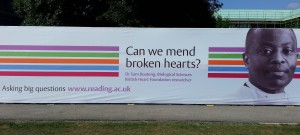Professor Peter Kruschwitz is Professor of Classics  at Reading and a specialist in Latin Language and Literature.
at Reading and a specialist in Latin Language and Literature.
The fence around the University of Reading’s Humanities and Social Science (HumSS) Building is currently decorated with images and captions illustrating Reading’s desire to be ‘asking big questions.’ One of the captions, attributed to Dr Sam Boateng from the School of Biological Sciences, asks: ‘Can we mend broken hearts?’
The caption, a playful curtsy to Reading’s leadership in cardiovascular research, reminded me of a passage attributed to the Latin poet Lygdamus, a love-poet of the first century B. C., who wrote in his Elegies 2.1-6:
Qui primus caram iuueni carumque puellae
eripuit iuuenem, ferreus ille fuit.
durus et ille fuit, qui tantum ferre dolorem,
uiuere et erepta coniuge qui potuit.
non ego firmus in hoc, non haec patientia nostro
ingenio: frangit fortia corda dolor.
‘He who first robbed a young man of his love, and a girl of her beloved, that person was made of iron. Hard, too, was he who could bear such pain, and who could live, with the partner snatched away. I am not strong in that respect, nor is there such endurance in my mind: pain makes brave hearts break.’
The image of heartbrokenness – ancient, yet familiar – begins to intrigue: how can a heart be broken, how can it get broken? Is it just the lack of resilience to emotional strain, one’s weakness, as Lygdamus suggests?
A possible answer can be found in even earlier Latin literature, in an author of the third and second centuries B. C. As far as one can tell from the fragmentary transmission of Latin literature, it may in fact have been the comic playwright Titus Maccius Plautus, who first employed it in his comedy Cistellaria (‘Casket Comedy’). In this play, Plautus has a lovesick young man called Alcesimarchus say (Cistellaria 221–2):
‘maritumis moribus mecum experitur: ita meum frangit amantem animum.’
‘He handles me the way the (stormy) sea would do: thus he breaks my lovesick heart.’
Plautus exploits the imagery of a ship exposed to the heavy sea, battered by the waves, lacking direction, and ultimately crushed to pieces by the forces of nature to describe the battles, external and internal, that Alcesimarchus has to face in his quest for fulfilled love.
From here it is only a small step to the image’s predominant use outside the realm of Latin poetry: here, animum frangere is frequently used particularly as an image denoting the ‘crushing of someone’s spirit’ (rather than heart itself – the Latin term covers both facets).
Yet, in Latin writing it does not always have to be debilitating trauma that may result in the proverbial ‘broken heart’. Quintilian, Rome’s first professor of Latin, when discussing the best way in which to design the epilogue to a courtroom speech, suggests in his Institutio Oratoria (11.3.170):
‘si misericordia commouendos, flexum uocis et flebilem suauitatem, qua praecipue franguntur animi quaeque est maxime naturalis: nam etiam orbos uiduasque uideas in ipsis funeribus canoro quodam modo proclamantis.’
‘If they (sc. the judges) are to be moved by pity, (sc. employ) an inflexion of the voice and a whiney sweetness, by which hearts are broken first and foremost, yet which is most natural: for you see parents bereft of their children, and you see widows, at the very funerals, lamenting in that peculiar song-like voice.’
Even this very small selection of Latin usages of the image of the broken heart does show: pain, worries, sorrow (and ultimately: death) are deeply connected to it – and the idea of suffering and even of death due to a broken heart (figuratively, not literally speaking) is not alien to the medical profession.
What is interesting to a linguistic scholar, of course, is how a verbal image that started its life as a poetic metaphor can be appropriated by the language of science – a language that often (albeit incorrectly) is deemed objective and descriptive.
The image of the broken heart that Dr Boateng uses in his big question is by no means an exception in that respect. Instead, it even adds another facet to it: the allusion to the image does not restore a literal facet of the phrase ‘broken heart’ that did not exist in its figurative use – hearts, unless subject to substantial physical force, do not literally break into pieces, like a clay vessel if dropped. Instead, it combines the pre-existing image with that of a broken piece of machinery (an engine, perhaps), thus expanding the metaphoric use rather than restricting it.
Dr Boateng asks a big question: ‘Can we mend broken hearts?’ – and I very much hope he can (or that he will be able to do that one day in the very near future). An even bigger question than this could be: ‘Should we mend broken hearts?’ One must not be cynical when it comes to deeply unsettling matters; yet, the answer to this question, whether for the scientific or the poetic use of the phrase, will have to remain a philosophical one.


